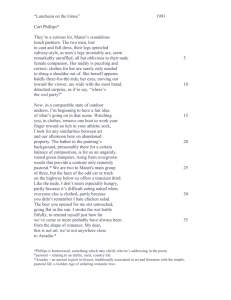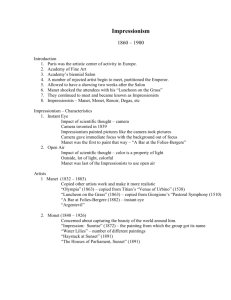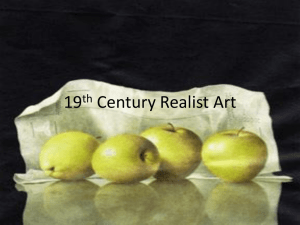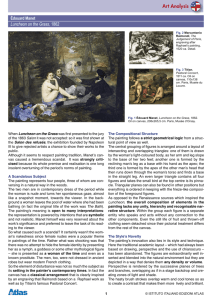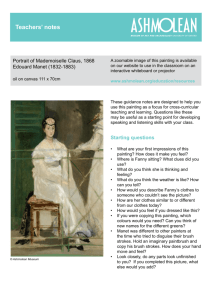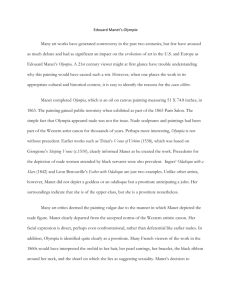Edouard Manet - Earlston High School
advertisement
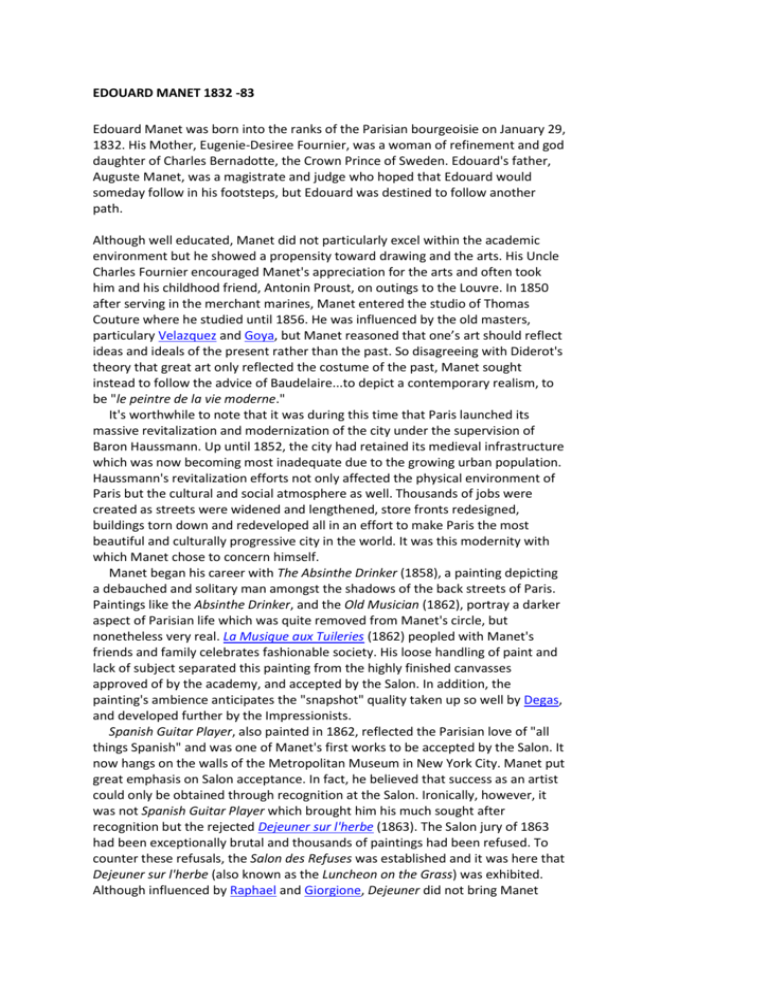
EDOUARD MANET 1832 -83 Edouard Manet was born into the ranks of the Parisian bourgeoisie on January 29, 1832. His Mother, Eugenie-Desiree Fournier, was a woman of refinement and god daughter of Charles Bernadotte, the Crown Prince of Sweden. Edouard's father, Auguste Manet, was a magistrate and judge who hoped that Edouard would someday follow in his footsteps, but Edouard was destined to follow another path. Although well educated, Manet did not particularly excel within the academic environment but he showed a propensity toward drawing and the arts. His Uncle Charles Fournier encouraged Manet's appreciation for the arts and often took him and his childhood friend, Antonin Proust, on outings to the Louvre. In 1850 after serving in the merchant marines, Manet entered the studio of Thomas Couture where he studied until 1856. He was influenced by the old masters, particulary Velazquez and Goya, but Manet reasoned that one’s art should reflect ideas and ideals of the present rather than the past. So disagreeing with Diderot's theory that great art only reflected the costume of the past, Manet sought instead to follow the advice of Baudelaire...to depict a contemporary realism, to be "le peintre de la vie moderne." It's worthwhile to note that it was during this time that Paris launched its massive revitalization and modernization of the city under the supervision of Baron Haussmann. Up until 1852, the city had retained its medieval infrastructure which was now becoming most inadequate due to the growing urban population. Haussmann's revitalization efforts not only affected the physical environment of Paris but the cultural and social atmosphere as well. Thousands of jobs were created as streets were widened and lengthened, store fronts redesigned, buildings torn down and redeveloped all in an effort to make Paris the most beautiful and culturally progressive city in the world. It was this modernity with which Manet chose to concern himself. Manet began his career with The Absinthe Drinker (1858), a painting depicting a debauched and solitary man amongst the shadows of the back streets of Paris. Paintings like the Absinthe Drinker, and the Old Musician (1862), portray a darker aspect of Parisian life which was quite removed from Manet's circle, but nonetheless very real. La Musique aux Tuileries (1862) peopled with Manet's friends and family celebrates fashionable society. His loose handling of paint and lack of subject separated this painting from the highly finished canvasses approved of by the academy, and accepted by the Salon. In addition, the painting's ambience anticipates the "snapshot" quality taken up so well by Degas, and developed further by the Impressionists. Spanish Guitar Player, also painted in 1862, reflected the Parisian love of "all things Spanish" and was one of Manet's first works to be accepted by the Salon. It now hangs on the walls of the Metropolitan Museum in New York City. Manet put great emphasis on Salon acceptance. In fact, he believed that success as an artist could only be obtained through recognition at the Salon. Ironically, however, it was not Spanish Guitar Player which brought him his much sought after recognition but the rejected Dejeuner sur l'herbe (1863). The Salon jury of 1863 had been exceptionally brutal and thousands of paintings had been refused. To counter these refusals, the Salon des Refuses was established and it was here that Dejeuner sur l'herbe (also known as the Luncheon on the Grass) was exhibited. Although influenced by Raphael and Giorgione, Dejeuner did not bring Manet laurels and accolades. It brought criticism. Critics found Dejuener to be antiacademic and politically suspect and the ensuing fire storm surrounding this painting has made Le Dejeuner sur l'herbe a benchmark in academic discussions of modern art. The nude in Manet's painting was no nymph, or mythological being...she was a modern Parisian women cast into a contemporary setting with two clothed man. Many found this to be quite vulgar and begged the question "Who's for lunch?" The critics also had much to say about Manet's technical abilities. His harsh frontal lighting and elimination of mid tones rocked ideas of traditional academic training. And yet, it is also important to understand that not everyone criticized Manet, for it was also Dejeuner which set the stage for the advent of Impressionism. Olympia, also painted in 1863, caused a similar uproar and the controversy surrounding these two paintings truly dismayed Manet. It was not at all his intention to create a scandal. Manet was not a radical artist, such as Courbet; nor was he a bohemian, as the critics had thought. Recently married to Suzanne Leenhoff, the well mannered and well bred Manet was an immaculately groomed member of high society. As Henri Fantin-Latour's Portrait of Manet suggests - this man was the quintessential Parisian flaneur. But Manet's unique technical innovations intrigued the likes of Pierre Renoir and Claude Monet and set free the traditional and conservative reigns of academic painting. Political events between the years 1867-1871 were turbulent ones for Paris, and the Franco-Prussian war left Paris besieged and defeated. Manet turned his eye to these events in his works entitled Execution of Maximilian, Civil War and The Barricade. In 1870, Manet sent his family south to protect them from the fighting in Paris and signed on as a gunner in the National Guard. There is much primary documentation in the form of letters to family and friends which expresses Manet's horror and dismay at the war and these paintings stand as testaments to Manet's sentiments. The Execution of Maximilian (1868) reaches out to Goya's Third of May but despite its masterly influence the painting was banned from being exhibited in Paris due to the "Frenchness" of the executioners costume. And yet along with his expressions of political disillusionment, Manet also continued producing works such as The Balcony (1868), Portrait of Emile Zola (1868), and The Railroad (1872). By 1874 Manet's reputation as experimental artist and leader of the Impressionists was firmly established. The Cafe Guerbois, near Manet's studio became the gathering spot for Monet, Renoir, Sisley, Degas and Pissaro and although Manet presided over the regular meeting and debates held at the cafe, he was not enthusiastic about his role as leader of the avant-garde. In 1874, when the Impressionists held their first exhibition at Nadar's studio, Manet refused to participate. He chose instead to remain focused on the Salon. He never exhibited in any of the eight Impressionist exhibitions and yet by no means did Manet abandon the Impressionists. He worked closely with Monet in Argenteuil during 1874 and often gave financial support to his friends who needed it. It was during this time that Manet came closest to painting in the Impressionist style. Painting en plein air Argenteuil and Monet's Boat Studio both approach the notions of reflected light and atmosphere of Impressionism but Manet never becomes assimilated into the true Impressionist style. In his last great masterpiece, Bar at the Folies-Bergère (1882), Manet returns again to studio painting, a somber palette and eliminated mid tones. The cafe concert is a theme which Manet had been treating in the late 70's in paintings such as Corner in a Cafe Concert and The Cafe. But here at Bar at the Folies- Bergere, we are no longer spectators, but participants in the painting. While the Barmaid occupies the center of the piece, the painting is filled with a menagerie of characters from seated couples to trapeze artists. Glittering chandeliers and electric lights fill the upper portion of the work. Here, as in Dejeuner sur l'herbe, optical contradictions abound. Throughout his works of art Manet painted modern day life, yet many of his paintings are so much more than simple mimetic depictions. If Manet's work seems to be full of contradictions, or to employ a lack of perspective from time to time, then perhaps that was the true reality of Paris in Manet's time. Always controversial, Manet sought to record the days of his life using his own unique vision. From beggars, to prostitutes, to the bourgeoisie he sought to be true to himself and to reproduce "not great art, but sincere art." He died, in Paris, on April 30, 1883. Edouard Manet paintings Music at the Tuileries 1862This painting of the Tuileries Gardens in Paris was Manet's first major work depicting modern city life. The band is playing and a fashionable crowd has gathered to listen.The picture includes portraits of Manet's friends and family. These include Manet himself as well as: Baudelaire - poet (1821 - 1867) Théophile Gautier - poet and novelist (1811 - 1872) Ignace Fantin-Latour - flower-painter (1836 - 1904) Jacques Offenbach (1819 - 1880) - composer Eugène - the artist's brother (1833 - 1892) Olympia 1863 In this famous painting, Manet showed a different aspect of realism from that envisaged by Courbet, his intention being to translate an Old Master theme, the reclining nude of Giorgione and Titian, into contemporary terms. It is possible also to find a strong reminiscence of the classicism of Ingres in the beautiful precision with which the figure is drawn, though if he taught to placate public and critical opinion by these references to tradition, the storm of anger the work provoked at the Salon of 1865 was sufficient disillusionment. There is a subtlety of modelling in the figure and a delicacy of distinction between the light flesh tones and the white draperies of the couch that his assailants were incapable of seeing. The sharpness of contrast also between model and foreground items and dark background, which added a modern vivacity to the Venetian-type subject, was regarded with obtuse suspicion as an intended parody. The new life of paint and method of treatment in this and the other works by Manet that aroused the fury of his contemporaries had a stimulus to give to the young artists who were eventually to be known as Impressionists. In a more general sense, they rallied to his support as one heroically opposed to ignorant prejudice and their own ideas took shape in the heat of the controversy. Dejeuner sur L’Herbe 1863 Rejected by the jury of the 1863 Salon, Manet exhibited Le déjeuner sur l’herbe under the title Le Bain at the Salon des Refusés (initiated the same year by Napoléon III) where it became the principal attraction, generating both laughter and scandal. Yet in Le déjeuner sur l'herbe, Manet was paying tribute to Europe's artistic heritage, borrowing his subject from the Concert champêtre – a painting by Titian attributed at the time to Giorgione (Louvre) – and taking his inspiration for the composition of the central group from the Marcantonio Raimondi engraving after Raphael's Judgement of Paris.But the classical references were counterbalanced by Manet's boldness. The presence of a nude woman among clothed men is justified neither by mythological nor allegorical precedents. This, and the contemporary dress, rendered the strange and almost unreal scene obscene in the eyes of the public of the day. Manet himself jokingly nicknamed his painting "la partie carrée". In those days, Manet's style and treatment were considered as shocking as the subject itself. He made no transition between the light and dark elements of the picture, abandoning the usual subtle gradations in favour of brutal contrasts, thereby drawing reproaches for his "mania for seeing in blocks". And the characters seem to fit uncomfortably in the sketchy background of woods from which Manet has deliberately excluded both depth and perspective. Le déjeuner sur l'herbe testimony to Manet's refusal to conform to convention and his initiation of a new freedom from traditional subjects and modes of representation - can perhaps be considered as the departure point for Modern Art. The Fifer 1866 The work combines interest in Japanese painting in stylization and the flat rendering, and in Velazquez, in rendering of no other background than air (a quality which Manet had admired in the Spanish painter. On first glance, Fifer (1866) is simply a painting of an innocent young boy. In reality, however, it is one of Manet’s oddest “portraits” of Victorine Meurent: she was one of several models who sat for the painting. As a result, her eyes seem to peer strangely from another’s face. The fifer’s intense but abstracted gaze and light, half-formed eyebrows seem lifted directly from The Street Singer, and the hand that blocks Victorine’s mouth in that painting is echoed here by the fife before the boy’s lips) a reminder of Manet’s obsession with control. For like The Street Singer, The Fifer is an attempt at concealment of Victorine’s body and sexuality - but this time, with flesh instead of cloth. Her sexuality is not merely hidden, but subsumed: by combining her with a prepubescent male, Fifer neutralizes Victorine’s female sexuality. Painted in the period between Olympia and Gare SaintLazare, Fifer signals Manet’s intent to drain the sexuality from his images of Victorine. The Street Singer The Fifer A Bar at the Folies Bergere 1881 by Edouard Manet (1832-83), the painter of modern life who scandalised the Parisian public with his tough nude Olympia (1863), his sleazy take on the pastoral Le Déjeuner sur l'Herbe (1863), and his brutal contemporary history painting The Execution of Maximilian (1867). Subject: Suzon, according to the recollections of Manet's friends: a young woman who worked at the Folies-Bergère, one of the great Parisian cafés-concerts , a kind of beer hall with music, circus acts and other entertainment. Distinguishing features: Suzon stands alone in a crowded room. The look on her face is detached, melancholy, distracted from her job serving at the bar in the vast crowded room reflected in the glass behind her. There is a locket around her neck that is a token of another life, a love a long way from this job. This is an unusual portrait because it is of someone at work, and someone who to our eyes is defined by her work and is profoundly unhappy with it. She is alienated from her surroundings, as if there is a glass pane between her and everyone else in the room - the drinkers, chatters-up, lovers, liars, thieves and businessmen. Manet conveys Suzon's estrangement from her world by the fact that she is the only person in this painting who is not reflected in glass. Everyone else in the painting is seen in the big bar mirror: the quickly painted, harshly reflected faces and bodies, a woman in gloves with her lover or client, someone else looking at the scene with binoculars. They are objects she is looking at - but at one remove, through a glass darkly. The only solid realities are the marble bar top and the bottles - crème de menthe, champagne, beer a bowl of oranges, two flowers delicately placed in a vase. She has both hands firmly on the bar as if she needs to touch something solid, in case she should be carried away by the vortex of light and shapes reflected in the mirror. This is not a realistic painting of the Folies-Bergère. Suzon did work there, but she posed for the painting in Manet's studio, behind a table laden with bottles. He merged this image with rapid painted sketches he made at the Folies-Bergère. There is no attempt to make the image cohere: there is, as contemporary critics pointed out, an inconsistency to the relationship between the reflections in the mirror and the real things. The man in the top hat approaching Suzon in a sinister way in the top right hand corner of the mirror would in reality have to be standing with his back to us in front of the bar, and Suzon herself should be reflected in an entirely different place. The dislocation of Suzon's world is deliberate. Paris is a hall of mirrors where Suzon floats helplessly, clinging to her bar. The flowers are a touching attempt to preserve a little humanity, as are her neat blue clothes and whole demeanour. It's amazing that contemporary critics saw her as a prostitute. And who are you? The top-hatted stranger, of course, the Jack the Ripper whose ghostly reflection approaches her with such menace in the mirror. Manet captures the coolness, cruelty and glamour of modern life. This is one of the keystones of modern art. Inspirations and influences: A Bar at the Folies-Bergère is a modern version of Velazquez's Las Meninas (1656-7), the most profound meditation on the portrait. In Las Meninas, ostensibly a picture of the royal Infanta and her retinue of children, pets and dwarf, Velazquez includes the king and queen reflected in a mirror at the back of this palace apartment. He himself stands painting them on a vast canvas looking at us, and we are the royal eye, looking back at the world that exists for our regal gaze. Manet worshipped Velazquez, and transferred this aesthetic of reflection to modern times, to create a world that only exists in mirrors; this turns the viewer into a spectral, disturbing presence, part of the crowd that Suzon looks at with such disillusion. The 20th-century painter whose portraits owe most to Manet was the flatly ironic Andy Warhol. Las Meninas by Velasquez
